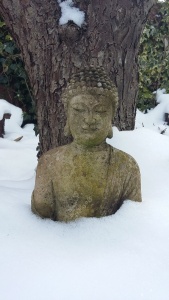
Inside Yoga 229 (19/3/2018)
What is meditation? This is a simple question but the answer can appear complex, or devoid of explanation, the general perception of meditation is of something mystical and distant. This blog offers a simple explanation.
In Matthieu Ricard’s book “Happiness” he writes, the “Tibetan word ‘gom’, which is usually translated as ‘meditation’, more precisely denotes ‘ familiarisation’, while the Sanskrit word ‘bhavana’, also translated as ‘meditation’, means ‘cultivation’. Indeed, meditation is not about sitting quietly in the shade of a tree and relaxing in a moment of respite from the daily grind; it is about familiarising yourself with a new vision of things, a new way to manage your thoughts, or perceiving people and experiencing the world.”
This description by Ricard, who has been a Tibetan monk since the 1970s, is useful way of unlocking the mystery of meditation, by using the word ‘familiarisation’ he instantly makes the practice accessible, because we all know what becoming familiar with something means. To become familiar with something we need to spend time with it, meditation in this case, until we feel at home with it, understand it, and can live with it.
This explanation is not just for seated meditation, but also yoga asanas and pranayamas, the physical postures and breathing exercises also require a familiarisation. This is all part of yoga, as I have described before, yoga is meditation (see blog link, https://www.yogabristol.co.uk/2017/03/13/yoga-is-meditation/ ) so in this way, yoga is familiarisation.
Going back to Ricard comment, “meditation is not about sitting quietly in the shade of a tree and relaxing in a moment of respite from the daily grind”, technically speaking this is correct, meditation is not meant as a relaxation exercise, however, it is important to understand that there will be times when meditating that we will feel all that is happening is just that – a relaxation and break from the daily grind. Firstly, although this is not the goal of practice it is a by-product of the practice, where we feel relaxation but no insights, and this is fine to allow it to happen but not to indulge in it. It might be that we are tired and the meditation allows us to relax for the first time in the day, before going into a deeper meditation. Admittedly, some of us will feel this is the only stage we experience. This is all part of the practice because as the practice continues, the insights will come as Ricard describes above, and first we need to shed the layers which might obscure our view of insights.
Secondly, I encourage people, especially beginners, to discover the sense of relaxation experienced while meditating, as described above, because this might be the precursor to deeper meditations which reveal what Ricard describes as “a new vision of things, a new way to manage your thoughts, or perceiving people and experiencing the world.” It helps to first quieten everything down, just sitting, just breathing, and this can be a very relaxing break from the daily grind.
During my practice and especially when doing long periods of meditation I would notice fluctuations in my mind state, from deep relaxation (a break from the daily grind) to deep insights into who I am and so forth. We learn to understand who we are through this practice, and as result we understand more about the world beyond our mind and body. It is also, a question of how far on the meditator’s journey we wish to travel. I encourage you to go the whole way.
Meditation has multiple layers and as we practice we will experience more and more or them, and the skill is to recognise the patterns of thoughts, emotions, feelings etc that we feel while practising, and this is why the word familiarisation is such an accurate way of describing the process of meditation.
The book: Mathieu Ricard “Happiness”
Any questions or comments contact me via the blog reply panel below or email gary@yogabristol.co.uk
Please share this blog with others… on social media or even via the ancient practice of face-to-face conversation
